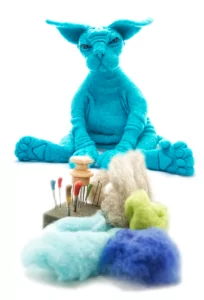“While our symptoms differ, we all desire to live well. At the end of the day, every human on this planet is unfixed.”

The filmmaker, photographer, and visual artist shares her past five years living with Mal de Débarquement Syndrome, and the inspiration behind her new project about chronic illness — “Unfixed”
Mal de Débarquement Syndrome (MdDS) throws people off balance in every aspect of their lives.
In Kimberly Warner’s case, MdDS derailed her thriving career as a filmmaker and photographer. Her award-winning work was published in a variety of magazines and for a long list of commercial clients. Then in 2015, Kimberly developed MdDS, a neurological disorder that manifested in her as a feeling of constant rocking, bobbing, and swaying — as if she’s on a boat.
“The unsteadiness that I live with feels like the ground is constantly moving under my feet. Laying down or closing my eyes does not make it stop. Whatever surface I’m on turns to liquid and my equilibrium is constantly trying to correct for it. Ironically, being in passive motion [such as driving in a car] is my only source of relief,” she says.
Kimberly has also experienced a strong gravitational pull to her right. She’s extremely sensitive to light and noises. In the lower left back of her head she’s felt a sharp pain and a loud vibrating sound.
“I call it the dumpster truck in my head,” Kimberly says.
Thankfully, the worst of her MdDS symptoms subsided to a more manageable level after about two years. Today her symptoms reappear strongly but only intermittently and usually coincide with high “wild seas” days: a constant perception of motion that feels like she’s bobbing at sea. Only motion, such as driving, makes the bobbing feeling recede.
Now five years into her vestibular journey, Kimberly has learned to persevere and live her life with purpose amidst nearly constant discomfort. She has also found ways to use her skillful storytelling abilities and thrive in new creative ways.
Her Vestibular Journey
Kimberly traces her MdDS back to an accident in May of 2014. While bicycling on a city street in Portland, Oregon, she crashed into a car door that suddenly swung open in her path, flipping her over the handlebars, breaking her pelvis, and cracking her helmet against the pavement.
After two months of recuperation, she started to walk again and had just started returning to normalcy when she experienced her first blackout. Shortly thereafter, she started having dizzy spells and other strange sensations. One time while driving, she felt like her car was doing a somersault. Another time it seemed like the countertop flipped on her, as well as other weird intermittent feelings.
“I felt like I was walking on a trampoline,” she says.
When the episodes became more frequent, she sought help from a variety of doctors: naturopath, two ENTs, a neurologist …
“There was a lot of shoulder-shrugging with doctors trying to figure out what was going on with me,” she says.
She saw a vestibular physical therapist who specialized in neck (cervicogenic) vertigo, but after a dozen sessions her symptoms worsened. The sensation of walking on a trampoline turned into wild dizziness, insomnia, and nerve pain coursing through her chest. She fell into a deep state of grief.
“At that point I was barely hanging on,” she says. “I wasn’t able to do daily walks around the block or go to the grocery store. I was not sleeping, not living anymore. I kept feeling like I just need to figure out what’s wrong with me so I can fix myself.”
Saved by Wool
 Feeling like she’d exhausted her medical options in Portland, Kimberly moved to Boulder, Colorado, to live with her mother. She sought out specialists, including an ophthalmologist who worked with traumatic brain injuries.
Feeling like she’d exhausted her medical options in Portland, Kimberly moved to Boulder, Colorado, to live with her mother. She sought out specialists, including an ophthalmologist who worked with traumatic brain injuries.
“Around that time, I picked up wool, which is what saved my life, and I don’t say that lightly,” she says. “I didn’t know how to get through the day since I wasn’t engaged anymore in a creative profession. So I started poking around with wool, which took enough of the peripheral ‘noise’ down to focus on my breath and the needle poking the wool.”
For the photographer and filmmaker, “noise” was visual feedback.
“Somehow limiting what my eyes were taking in and focusing on a singular object, I was able to calm my nervous system,” Kimberly says. “Minimizing some of my sensory stimuli always helps calm me, even if it doesn’t remove the perception of being at sea.”
For the next seven months, Kimberly needle-felted between doctor visits, holding onto the hope that she could get “fixed.” She eventually returned to Portland with a clowder of sculpted woolen cats, but without a firm diagnosis and not feeling much better, and in some ways worse. Drained financially and emotionally, she was beset by a newfound sense of hopelessness.
“One day, a family member asked me, ‘What if you have to live like this for the rest of your life?’ I didn’t like that suggestion but it planted a seed in me,” Kimberly says.
The idea of what would it be like to be “unfixed” compelled her to find other people also living with chronic illness. She searched online and discovered a Yahoo group devoted to MdDS.
“I could not believe how much resonance I felt with all these other people who have exactly what I have,” she says. “I took literature to my doctor so she could confirm my diagnosis, so I can start being treated properly.”
Recently, Kimberly connected with Sandy Brunner, a fellow Mal de Debarquement Syndrome and vestibular migraine sufferer who goes by @LifeWithoutLandLegs on Instagram. Sandy told Kimberly about VeDA and the resources available on their website, vestibular.org.
“Sandy and I connected over social media. Like me, she has issues with screens, so she asked if I’d hop on a call and we talked on the phone for a few hours. She has been so helpful,” Kimberly says.
Kimberly wishes she had connected with VeDA’s community earlier in her journey, and she wonders whether being better informed earlier on might have saved her from follow-up tests on brain injuries, when doctors felt certain she didn’t have a vestibular disorder.
Life Unfixed
 “The early stages of MdDS were so excruciating,” Kimberly says. “It was the first time I didn’t have an answer for something. I couldn’t control it. Up until then, everything in my life was oriented to success.”
“The early stages of MdDS were so excruciating,” Kimberly says. “It was the first time I didn’t have an answer for something. I couldn’t control it. Up until then, everything in my life was oriented to success.”
Despite the challenges she faces living with MdDS, she found another creative outlet by starting work on a film she’s titled “Unfixed,” documenting people living with debilitating chronic illness.
“I needed to find other people living with chronic conditions, people grappling honestly and creatively with the limitations of their bodies, and I needed to know how they were doing it,” she says in the film’s trailer.
She began the project in September 2019 and had hoped to be finished with filming by now, but the pandemic interrupted the shooting schedule in February 2020.
Since then she’s adapted from filming on location with a crew to remotely, which has opened up other creative opportunities. The people whose lives she set out to document are actually filming themselves.
“The camera allows people to show from their perspective what they are experiencing in their bodies. That’s especially enlightening for people with invisible illnesses. From the outside we look totally normal,” she says. “Inside it’s the messy, uncomfortable journey of being alive — with no fix in sight.”
For more info about Kimberly, visit unfixedfilm.com, liferaftmdds.com, and kimberlywarner.com.